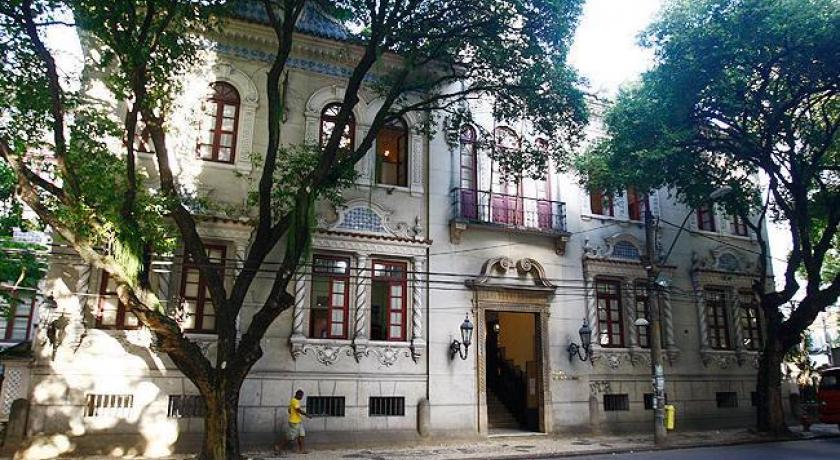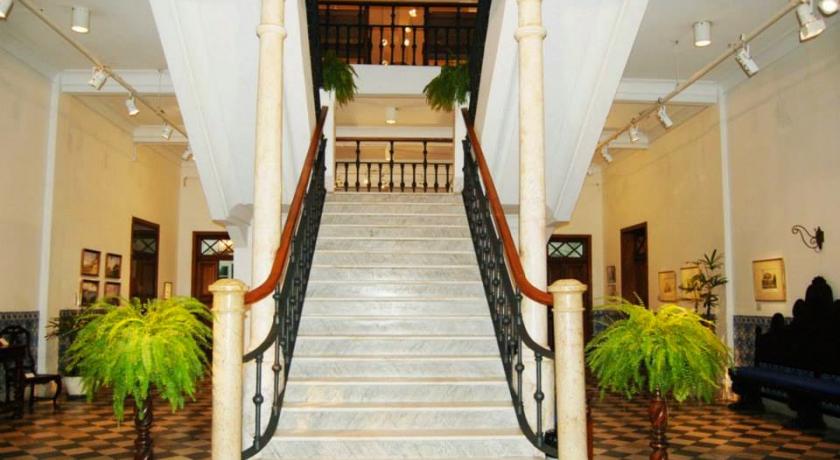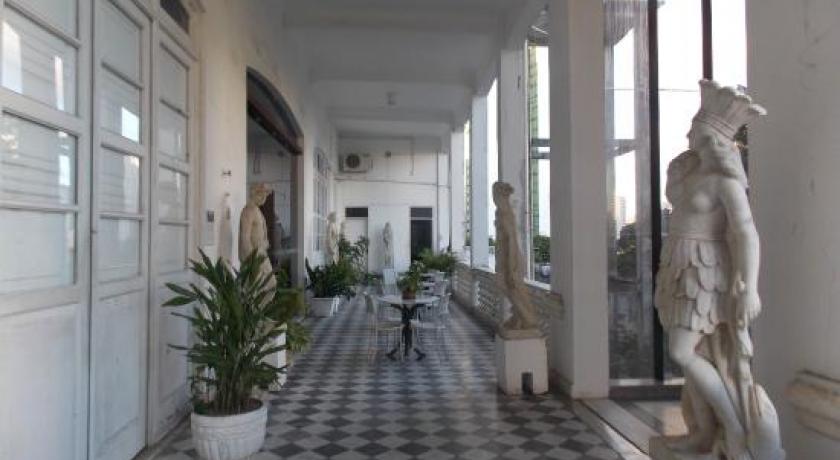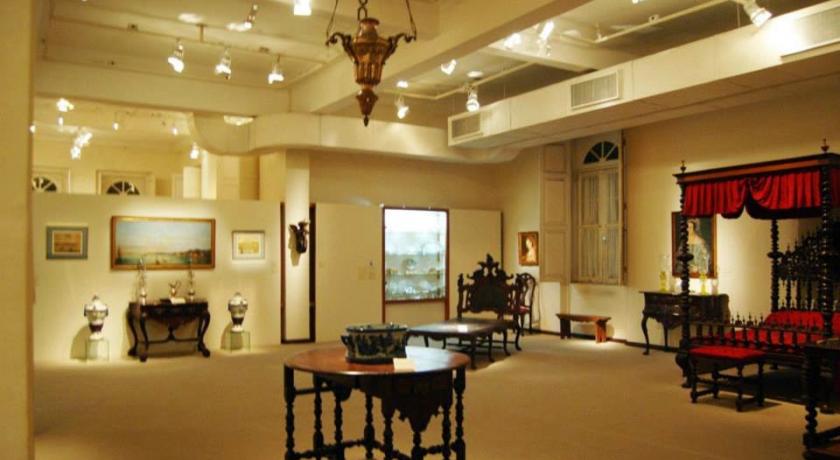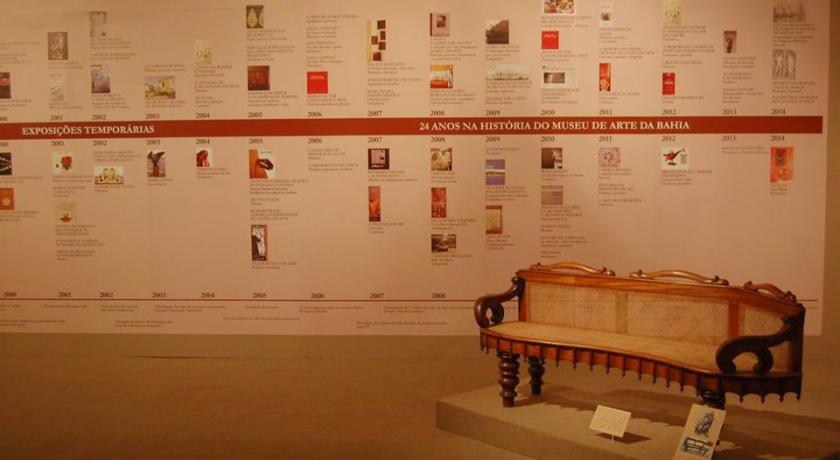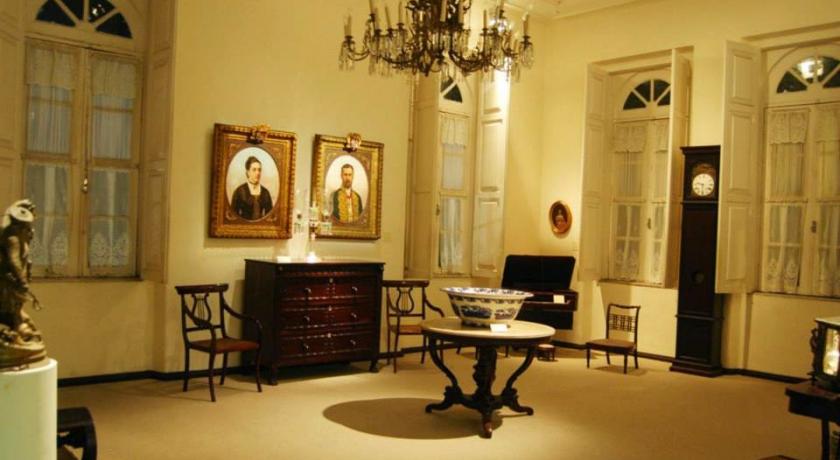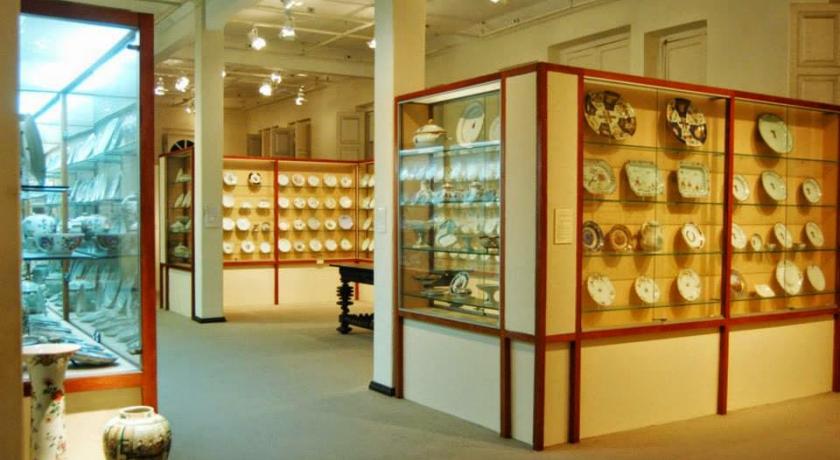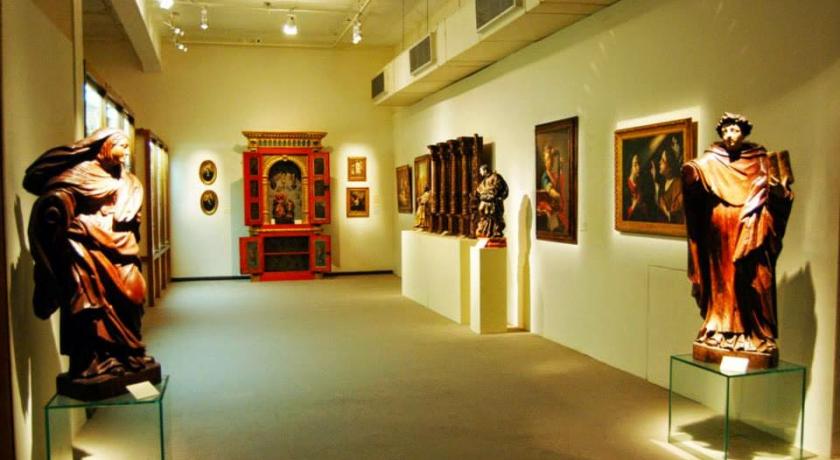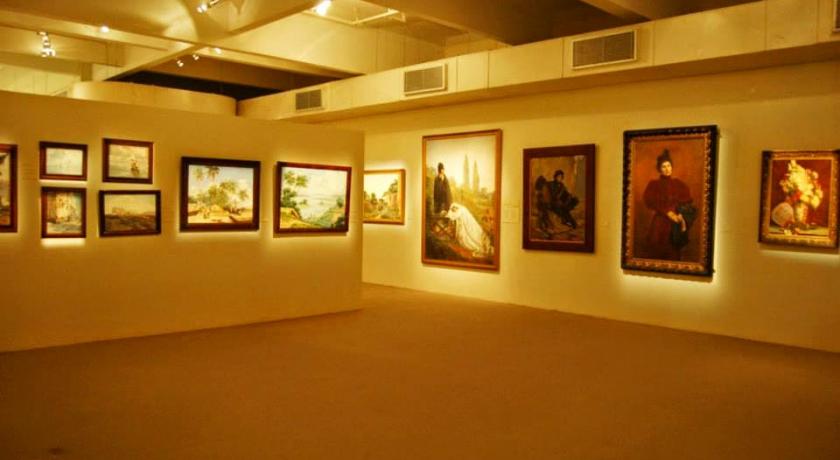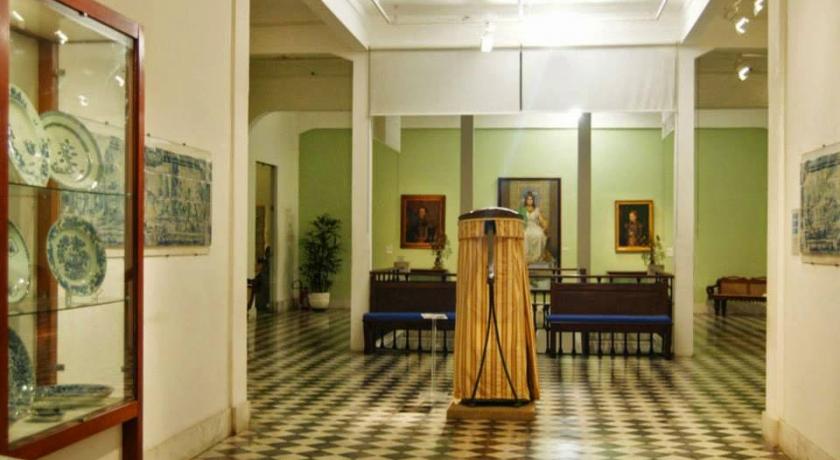Description
The Bahia Art Museum (known by the acronym MAB ) is a state public museum located in the city of Salvador .Founded in 1918 , it is the oldest museum in Bahia and one of the first ten founded in Brazil . Established according to the model of an encyclopaedic museum, under the name of State Museum, the institution emerged as a depository of the historical , ethnographic and scientific heritage of Bahia, gradually becoming specializing in the following decades as a museum space devoted to the visual and decorative arts .
It has a collection of approximately 5,000 works of great historical and artistic value, formed by the gathering of several collections organized in Bahia since the mid- nineteenth century , such as those of Jonathas Abbott and Góis Calmon , both acquired by the Bahia government. The collection includes paintings from the Bahian school and foreign artists, dating from the 16th century onwards, imaginary from the colonial period and a wide array of decorative arts, with Brazilian, European and Oriental pieces. It also has a rich collection of documents, photographs, maps, correspondence, etc.
Since 1982 , the Bahia Museum of Art has been housed in the Palácio da Vitória , a neocolonial style building that has served as the seat of the Education and Health Secretariat in the past. It has a specialized library with about 12,000 books, and auditorium. The MAB hosts permanent and temporary exhibitions and organizes multiple cultural activities, such as courses, lecture cycles, musical performances and film screenings.
History
Background
A substantial part of the historical-artistic heritage now preserved in the Bahia Art Museum has its origin in the collection of works of art by Jonathas Abbott , an English physician living in Salvador in the first half of the 19th century . A noted collector, Abbott has assembled, over many decades, almost 400 pieces, mostly paintings. Foreign works were probably acquired on the occasion of Abbott's stays in Europe in 1820, between 1830 and 1832 and between 1852 and 1853.
With regard to Brazilian art , Abbott dedicated himself to acquiring works from the Bahian school of painting (paintings and panels by José Joaquim da Rocha , José Teófilo de Jesus , Franco Velasco , etc.), constituting a rare, if not unique, example , of collectionism focused on the art of the Brazilian colonial period in the nineteenth century - with the consolidation of academicism , the artistic production of colonial times was for a long time ignored or relegated to the condition of inferior artistic culture, a situation that would only begin to change from the action of the first generation of modernists .
After Abbott's death, a small part of his collection was dismembered and followed along with his son to Rio de Janeiro . [ 5 ] Most of the remaining pieces were purchased from the physician's family in 1871 by order of Francisco José da Rocha, vice president of the province of Bahia. With the acquisition, Rocha sought to form an art gallery at the Liceu de Artes e Ofícios . The pieces acquired by the provincial government were chosen by a commission, which included the painter José Rodrigues Nunes . The screens remained exposed in the rooms of the Liceu until the year of 1925 .
The foundation and the early years
The Museum of Art of Bahia was officially established on July 23 , 1918 , under the name of State Museum of Bahia. Established by Law no. 1 255, during the government of Antônio Muniz Sodré de Aragão , it was the first museum institution in Bahia and one of the first ten in Brazil. During the first decades of existence, the State Museum would function as an annex of the Public Archive of Bahia (created in 1890). It did not have the current profile of a museum of visual arts , but rather of an encyclopedic museum, of a historical-naturalist nature, bringing together a diverse collection composed of engravings , furniture , numismatics , ethnological collections and pieces related to the natural sciences . The historian Francisco Borges de Barros , one of the main idealizers of the institution, was named as its first director, remaining at the head of the museum until 1930, during which time he also accumulated the position of director of the Public Archive.
During the government of José Joaquim Seabra , the Public Archives and the State Museum had their functions and organizational structures regulated by Decree No. 2202 of June 26 , 1920 . The two institutions are now managed by the Secretariat of the Interior, Justice and Public Instruction. The collection of the State Museum, organized into three main sections (ethnology, numismatics and history) gradually expanded through acquisitions and donations. In 1925, by decision of the Gool Calmon government, the Jonathas Abbott collection, which until then had been preserved in the Liceu de Artes e Ofícios, was transferred to the State Museum, giving rise to a new nucleus of the collection: the gallery , representative Bahian authors. Still in the government Gol Calmon, the museum had its name changed to Museum of the Bahia. The collection was reorganized into the archives, museum and numismatic cabinet sections.
In 1930, during the government of the intervener Bastos do Amaral , new decrees altered the structure of the institution. The Public Archive was elevated to the status of province (under the name of the Public Archive and Monuments Inspectorate) and the art collection gained the status of an independent body, dismembering itself from the archive and being renamed as the Pinacoteca of the State of Bahia. Historical Museum (collections of ethnology, history, natural sciences and numismatics) as an annex. But it was only in the following year that the historical-artistic collection of the gallery and its annex was opened for public visitation, after its installation at Solar Pacífico Ferreira, located in the Praça Dois de Julho, Campo Grande neighborhood, on the land where it is today built the Castro Alves Theater . In 1931, the library of the museum was inaugurated.
The Valladares administration
In 1933, by decision of the Juracy Magalhães government, the institution was elevated to the category of province, under the denomination of Pinacoteca and Museum of the State, happening to be directly subordinate to the Secretary of the State of the Interior, Justice and Public Health. The inspectors Gabriel Inácio Godinho, Antonio de Araújo Bulcão Sobrinho and Guiomar Carvalho Florence succeeded each other in their direction throughout the thirties . In the latter's management, a new statutory reform linked the institution to the Secretariat of Education, Health and Public Assistance. The holder of this folder, Isaías Alves , played a prominent role in the orientation of the institution towards the profile of a popular center for historical, artistic and ethnographic studies, of a predominantly pedagogical nature.
From 1939, the Pinacoteca and Museum of the State of Bahia began to be managed by the historian and art critic José Antônio do Prado Valladares . His administration, which lasted until his death in 1959, was of great relevance for the consolidation of the institution as a museum of visual arts, as well as for the standardization of its functions and for its projection in the national scope. Valladares was responsible for the first activities of systematic cataloging of the collection and organization of museum and historical documentation. It started a line of publications edited by the museum itself, contributing to the development of research based on the collection itself. He created the Bahia Salon of Fine Arts , based in the institution for almost a decade, responsible for attracting the attention of artists and art critics from all regions of Brazil to the institution. Finally, it contributed to the expansion of the museum library, acquiring a large specialized bibliography. The studies and publications of Valladares, like his book Museums for the town , result of studies realized in the United States , constitute until today a reference of first importance for the Bahian museology .
In 1943, the collection of the museum was significantly enriched thanks to the acquisition of a large collection of decorative arts , consisting of important pieces of Bahian furniture , oriental and European porcelain , crystals , goldsmithery , silverware , religious sculptures and paintings. former Governor Góis Calmon. On the same occasion, the state government also acquired the mansion where Góis Calmon lived, located on Avenida Joana Angelica, in the neighborhood of Nazaré . Three years later, the institution was transferred to the mansion, after remodeling and adaptation, since the Solar Pacific Pereira no longer behaved the growing collection.
From the 1960s to the administration of Emanoel Araújo
In 1959, the collection of modern and contemporary art from the Pinacoteca and State Museum of Bahia was dismembered and transferred to the Solar do Unhão , serving as the base of the recently founded Museum of Modern Art of Bahia , directed by Lina Bo Bardi . Following Prado Valladares, Carlos Eduardo da Rocha assumed the same direction of the museum, remaining in the position until 1974.
During the government of Luis Viana Filho , the headquarters of the museum, Solar Góis Calmon, underwent a comprehensive renovation. According to the works, part of the collection was transferred to temporary places, namely the rooms of the Convento do Carmo . Other works were transferred on a lending basis to the Engenho Freguesia architectural complex in the town of Candeias , serving as the inaugural collection of the Wanderley Pinho Recôncavo Museum , which was created in 1971. After its renovation in 1970, the institution, now renamed the Art Museum of Bahia, was reopened to public visitation.
After Carlos Eduardo Rocha, MAB's director was Ana Lúcia Uchoa Peixoto (1975-1979), the art decorator and critic José de Souza Pedreira (1979-1981) and the plastic artist Emanoel Araújo (1981-1983) . During the administration of Emanoel Araújo, with the support of the then governor Antônio Carlos Magalhães , the museum was transferred from Solar Góis Calmon to its current headquarters, Palácio da Vitória , on Sete de Setembro Avenue. The transfer of the institution, a long-standing claim of museum staff and the local artistic community, came after a long renovation in the palace to adapt it to museum needs. The director of the museum was in charge of the planning and execution of the transfers. The MAB was reopened on November 5 , 1982 .
The new space allowed MAB to expand its activities according to the model of a cultural center , hosting multiple activities such as temporary exhibitions, courses, conferences, concerts and film sessions. Still under the management of Emanoel Araújo, much of the collection was restored.
From the 1980s to the present day
After the departure of Emanoel Araújo, the plastic artist Luiz Jasmin (1983-1987) and the museologists Antonia Barros Pinheiro (1987-1989) and Valdete Paranhos (1989-1991) succeeded to the Bahia Museum of Art. In the latter's management, the museum was forced to close the doors to public visits, only seven years after its re-inauguration in the Victory Palace, due to the lack of maintenance of the property, coupled with several other deficiencies.
In 1991, the museologist Sylvia Athayde took over the direction of the MAB, remaining in the position until today. In its management, the museum was reopened after two years of suspended activities. Extensive renovation was carried out on the internal spaces and facade of the building and the electrical and hydraulic networks were rebuilt. The Athayde administration also devised a new museographic orientation, establishing two independent exhibition circuits in rooms dedicated to the permanent collection. Athayde coordinated the work of restoring parts of the collection, covering 90% of the collection of works on paper, 50% of the collection of painting and some important pieces of the collections of sculpture, furniture and porcelain.
In 1994, with the support of Odebrecht , the museum installed air conditioning and humidity control equipment in temporary exhibition halls, adapting the space to the international criteria for reception of itinerant exhibitions. The following year, with subsidy from the state government, the technical reserve and the museum auditorium received air conditioning equipment. More recently, MAB's management presented a proposal to expand the museum's physical space, through the construction of a building adjacent to the Victory Palace, with access through the Canela Valley. The new space would house the Museum Theater, a café-restaurant, patio for musical performances and other services for visitors.
The building
The Palácio da Vitória, currently home to the Bahia Art Museum, is located on Avenida Sete de Setembro, in the section known as "Corredor da Vitória", in the neighborhood of the same name in Salvador . The place is a prominent area in the city for having sheltered until the mid-twentieth century mansions belonging to traditional families of Bahian society.
In the land where the headquarters of the MAB is located today, at the beginning of the 19th century, there was a mansion erected at the request of the wealthy slave trader José de Cerqueira Lima. After its acquisition by Francisco Pereira de Almeida Sebrão in 1858, the mansion was transformed into the São José College , an institution of great relevance in the history of Bahia's pedagogical and cultural evolution. In 1879, acquired by the government, the palace was used as the official residence of the presidents of the province. After the Proclamation of the Republic in 1889, it continued as official residence, under the denomination of Palace of the Governors. During the government Gol Calmon (1924-1927), the palace, in bad state of conservation, was demolished.
Still in the Góis Calmon government, the construction of the current building, in reinforced concrete and neocolonial style, was begun to serve as headquarters for the Secretary of Education and Health. In the decoration of the facade and the internal spaces were used several architectural elements originating from other solar demolished Particularly noteworthy is the seventeenth century stone and carved woodwork, dating from 1674 and coming from Solar João de Aguiar Matos. Endowed with sandstone frame, forming a drawing of braids and pediment with scrolls , the cover is equipped with a monumental door in jacaranda and vinhático , carved and decorated with rectangular panel motifs and bas-relief masks. Another important element is the stepped banister of the noble staircase, from the former Convent of Santo Antônio do Paraguaçu , in the Recôncavo Baiano , formed by sections of a communion grid, with turned columns and carved figures, quite representative of the baroque carving .
In the interior spaces of the two floors of the building, the decoration in tiles is outstanding. The ground floor hall is lined with blue and white tiles from the 19th century.Scattered in the hall are a series of marble statues, including four allegorical works of the stations, which originally decorated the balustrade of the Town Hall, in the surroundings of the Lacerda Elevator . The auditorium is lined with neoclassical tile panels, probably made by the Royal Rat Factory of Lisbon , representing oval medallions with landscapes and bucolic scenes surrounded by garlands , as well as other panels of yellow and white tiles from the Fábrica das Devesas do Porto , also of the nineteenth century. The boardroom is decorated with seventeenth-century Portuguese tile panels in "carpet" pattern in yellow, blue and white.
Formation of the collection
The collection of the MAB was formed by the union of several collections amealhadas in Bahia by private individuals and by representatives of the public power since the mid-nineteenth century. It stands out as the fundamental nucleus of the collection, the collection of the doctor Jonathas Abbott, composed of Bahian paintings from the 18th and 19th centuries and by European paintings dating from the 16th century onwards. Acquired by the provincial government in 1871, it became the first public art gallery in Bahia.
In 1943, another major acquisition for the collection was made by the state government. It is the collection of former governor Góis Calmon, gathering pieces of decorative arts (oriental and European porcelain, silverware, goldsmiths, crystals, furniture), imaginary sacred and paintings. In 1982, the posthumous donation of its former director, José Quarreira, was added to the MAB collection, a small but highly representative collection of approximately 50 pieces, including furniture, oriental and European objects.
In the last decades, the policy of expanding the collection developed by the museum's successive efforts has sought to fill significant gaps in the collections of painting, sculpture and decorative arts, notably with regard to the 20th century Bahian painting core, as well as to introduce new nuclei of collecting. In this sense, the collection of textiles and clothing, whose development was greatly encouraged thanks to the increase in donations that followed a temporary exhibition on children's clothing, headquartered in the museum in the 1990s .
Characterization of the collection
The collection of the Museum of Art of Bahia consists of approximately 5,000 pieces of varied types, functions, materials, techniques, provenances and periods, distributed in collections of paintings , religious sculptures , porcelain , furniture , silverware , glass and crystals , numismatics , drawings and engravings , as well as a small nucleus of objects of feminine use, such as jewelry , fans and clothing . The museum also houses a rich collection of documents , including photographs , letters(highlighting the correspondence exchanged between the poet Arthur de Salles and the historian João da Silva Campos ), postcards , invitations, menus, prints and old maps , a total of 6 200 objects. The library , founded in 1931 by the historian Francisco Borges de Barros, has about 9,000 books, a newspaper library with more than 15,000 newspaper clippings, a section of periodicals with more than 260 titles and other items.
Brazilian paintings
The collection of Brazilian paintings from the Bahia Museum of Art is characterized by a deep emphasis on the Bahian school , represented by countless notable examples of its most outstanding authors. It covers the period that extends from the mid- eighteenth century to the first decades of the twentieth century , addressing religious themes , portraits , allegories , nudes , gender , interiors, landscapes , navies and still lifes .
In the segment referring to the colonial painting in Bahia, the twelve biface paintings by José Joaquim da Rocha , one of the founders of the school, stand out on one side of one Passos da Paixão and on the other an angel bearing insignia. They were commissioned by the Holy House of Mercy to be used in the former Fogarian Procession, which was extinguished in 1875. There are a large number of works by José Teófilo de Jesus , a disciple of Rocha, addressing mythological, historical and religious themes. Of note are the allegories of the four continents, Africa , Asia , America and Europe . Franco Velasco , also a disciple of Rocha, is represented by a set of studies for the panels of the lateral chapels and the ceiling of the nave of the Bonfim Church . From José Rodrigues Nunes, the museum preserves five panels representing scenes of the Passion, executed for the Passos da Ajuda Procession, as well as portraits and copies of European originals. There are also works by Bento Capinam , Luís Gomes Tourinho and Cândido Ribeiro , among others.
In the middle of the nineteenth century, academicism was consolidated in Bahia, especially after the arrival of the Spanish painter Miguel Navarro Cañizares in Salvador, whose museum preserves some portraits. Also of academic invoice is the work of João Francisco Lopes Rodrigues , present in the collection with ten screens, between portraits and still lifes. His son, Manuel Lopes Rodrigues , a student of Cañizares at the Lyceum of Arts and Crafts and one of the most important painters of Bahia in his time, is present in the collection with masterpieces of his Parisian period, such as O goodbye , The two veils , Orchestra the procession in Brittany and the Republic , as well as still lifes, various landscapes and portraits.
Also worthy of note are: Rodolfo Amoedo , with a Still Life , an unusual piece in his eminently historical production; José Antônio da Cunha Couto , present with portraits of Bahian personalities and with the allegorical canvas Dispute among cosmographers , perhaps painted on the occasion of the fourth centenary of the discovery of America ; Francisco da Silva Romão , with Santa Cecilia playing the lute ; Antonio Olavo Baptista , with Portrait of Prisciliano Silva and a study of artistic nude; Prisciliano Silva , student of Manuel Lopes Rodrigues, author of a series of interior paintings of Bahian churches and convents, as well as portraits and landscapes;Alberto Valença , contemporary of Prisciliano, with European and Brazilian landscapes, as well as portraits; Manuel Mendonça Filho , painter of navies; Oséas dos Santos , Robespierre Farias , Vieira de Campos and others. The Brazilian painting of non-Bahian authors is represented in the collection in a timely manner. Outstanding are the Piauiense Lucílio de Albuquerque , with Mãe Preta , and the Fluminense Antônio Parreiras , with Landscape .
Foreign Paintings
The Museum of Art of Bahia has a numerically significant collection of foreign paintings, acquired mostly by Jonathas Abbott in Europe during the 19th century. The collection covers religious, mythological, allegorical paintings, portraits, genre scenes, landscapes and still lifes from various European schools ( Italian , French , Spanish , Flemish , Dutch , English ) dating from the sixteenth century onwards, especially in the seventeenth century (referring to the Baroque ) and XVIII (referring to the Rococo ). Many of the foreign paintings that make up the MAB collection have in the past been associated with big names in Western art , but most often based on hasty comparisons or superficial approximations - something understandable in the context in which the collection was formed, in the first half of the nineteenth century, distinguishing original works from copies was an arduous task even for European specialists.
In the twentieth century, stricter methods of investigation led to the emergence of new attributions and more precise diagnoses as to the nature and importance of these works. Between 1946 and 1947, the collection of European paintings of the MAB was examined by Robert Chester Smith , specialist of the British Crown . In 1948, they passed by the expertise of Germain Bazin , conservator of paintings of the Louvre Museum . More recently, they have been examining the collection Pietro Maria Bardi , director of the São Paulo Museum of Art and Luciano Migliaccio , a professor at Unicamp . It is worth mentioning, as a direct result of the studies of Migliaccio, the presence of three works of the MAB collection in the exhibition Arte Arte in Brazilian collections , held at MASP between 1996 and 1997, marking for the first time the participation of MAB in events of this nature.
Although the question of attributions remains problematic, there are works of indisputable technical and artistic quality integrating the foreign acquis of MAB. Among others, the Portrait of Woman , attributed to Francisco de Goya , Head of Saint , attributed to Giovanni Lanfranco , the pair of allegories Science and Peace , attributed to Sebastiano Conca and Saint John Nepomuceno , of a Florentine painter of the century XVII, perhaps Carlo Dolci . More recent conjectured attributions of Italian works of the collection point to names like Corrado Giaquinto , Giacomo Cavedoni , Giovanni Domenico Ferretti , Giuseppe Nicola Nasini and Paolo De Matteis . Among the pieces of authored safety, stand out Portrait of lady of Édouard Viénot and View of the Port of Salvador in the nineteenth century by Giuseppe Leone Righini . There is also a set of copies of famous works by Guido Reni , Caravaggio , Annibale Carracci , Murillo , Rembrandt , Theodore Géricault , etc.
The MAB preserves a very significant collection of religious images, coming from Brazil , especially from Bahia, Portugal and the Portuguese East , almost all of them due to active santeiros between the 17th and 19th centuries. They are erudite or popular representations of Jesus Christ , the main invocations of the Virgin Mary and the most popular saints of the Christian devotionary. Most of the sculptures, following the trend of this period of Portuguese-Brazilian art, are of anonymous artists and artisans, have small dimensions and were intended for use in private oratories . Less frequently, images of monumental proportions were generally intended for church altars or chapels of the engenhos and solar of Bahia. There is a small set of pieces attributable or due to renowned artists such as Manuel Inácio da Costa , Aurelio Rodrigues da Silva , Basílio Antonio Rodrigues Setúbal , among others. It stands out the monumental Christ Crucified , with 137 centimeters of height, attributed to Domingos Pereira Baião , made with jacaranda, silver, gold and rubies.In the segment related to the oriental imagery, the most prominent are the pieces from Portuguese India , mainly from Goa and Ceylon , in which the use of ivory as a raw material predominates.
Porcelain
The porcelain collection is one of the most important collections that make up the MAB collection. Most are Chinese-made and almost all were produced during the Qing Dynasty . Favored for its strategic geographical position, as a stopover for European ships returning from Asia with cargoes, as well as for its capital condition until 1763, the city of Salvador was for a long time the destination of much of the chinaware (usually called "porcelain Company of the Indies ") that contributed in the West, which explains the vast amount of these pieces in Bahian private collections and, consequently, in the Museum of Art of Bahia. The collection includes tableware,bowls, tureens , beams and plates , as well as polls , bottles , spittoons and ornamental objects such as pots , vases , potiches , figures and figurines .
The Peasants Service , the "roosters" and the "deer", were popularized after the transfer of the Portuguese court to Brazil. Highlights include the decorated dishes and a toilet with fountain and basin of the "green family"; medallion plates, jars and powder-blue potiches of the "pink family"; Chinese imari, plates, bowls and pots decorated with dark blue, red-orange and gold enamels ; jugs of the type garniture de cheminée ; a number of blue and white dishes, also known as "de Macau", and monochrome porcelains in blue with a golden ribbon, made in China exclusively for export, in accordance with European taste.
The segment is related to European porcelain is mostly composed of French pieces of the eighteenth and nineteenth centuries. They are tea and coffee services, plates, platters, bombonières and decorative figures, produced by manufactures like Sèvres and Jacob Petit . To a lesser extent, the English schools ( Wedgwoodfaience ) and Portuguese schools are represented (highlighting a set of utilitarian and decorative pieces of humorous touch, produced by Rafael Bordalo Pinheiro ).
Silverware and goldsmithing
The MAB has a valuable collection of silver objects from the 18th and 19th centuries, where pieces related to the Catholic liturgy (church lamps, boilers, chalices, osculars, etc.) predominate, as well as neoclassical salutes , candlesticks , , bunches of frills , towel racks, popular jewelery copies, etc. They are mostly Bahian parts, and other Brazilian production centers, such as Rio de Janeiro, and foreigners, especially Portugal, are also represented. Among the highlights is a camelbaiana of silver with applications of gold, as well as an altar garnish, composed by four jars of angelica among foliages, sealed by a six-point bow. There are a fair number of recorded pieces, especially those due to the rehearser Manuel Eustáquio de Figueiredo , as a set of gum and basin and punch-shaped urn. Among the gold objects , the jewels stand out, such as "cup" and "cuff" bracelets, creole chains, chains, ball necklaces and medallions.
Furniture
The MAB furniture collection is composed of pieces from old families and religious and public institutions of the state, being highly representative of the aesthetic evolution, habits and ways of living of Bahian society over time. The collection includes a large variety of furniture from the 18th century Bahian baroque (styles D. João V and D. José ), such as chests , chairs , canapés , owls , various types of table , beds , paper tables , oratories , etc. From the 19th centuryThere are several copiesneoclassical , grouped in styles Empire and King John VI , such as tables, chairs, dressers , consoles , couches , preguiceiros , tremor , dressing tables , dobbies and oratorios. Prevail in the collection the pieces made with woods native to the region, such as jacaranda and vinhático . To a lesser extent, furniture from other regions of Brazil and other countries, such as Portugal, Portuguese India and France, are present in the collection.
Amongst many others stand out: a large seat seat in the seventeenth century from Casa da Relação; of the eighteenth century, a rare accountant with multiple drawers, with ivory inlays, and a jacaranda canopy bed , richly decorated with shells, scrolls, foliage and the "fronton", crowned by bobbins and supported by columns turned in spiral and baluster; nineteenth century a seat of arruar , a sofa in mahogany and rattan unusual format, coming from the old Teatro São João, and a curious pianola-seamstress, French play in pine, which aimed to meet the most common requirements of nineteenth-century female education.
Source: https://pt.wikipedia.org/wiki/Museu_de_Arte_da_Bahia
Address
Salvador
Brazil
Lat: -12.993588448 - Lng: -38.525962830


